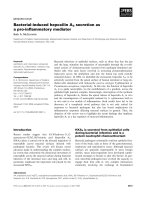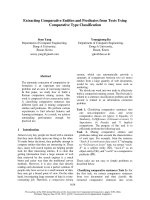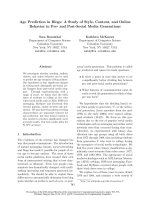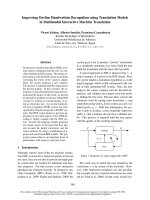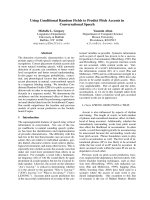Báo cáo khoa học: " Between prediction, education, and quality control: simulation models in critical care" pptx
Bạn đang xem bản rút gọn của tài liệu. Xem và tải ngay bản đầy đủ của tài liệu tại đây (33.99 KB, 2 trang )
Page 1 of 2
(page number not for citation purposes)
Available online />Abstract
Today, computer-aided strategies in social sciences are an
indispensable component of teaching programs. In recent years,
microsimulation modeling has gained attention in its ability to
represent predicted physiological developments visually, thus
providing the user with a full understanding of the impacts of a
proposed scheme. There are several microsimulation models in
human medicine, and they can be either dynamic or static. If the
model is dynamic the course of variables changes over time; in
contrast, in the static case time constancy is assumed. In critical
care there have been several approaches to implement
microsimulation models to predict outcome. This commentary
describes current approaches for predicting disease progression
by using dynamic microsimulation in pneumonia-related sepsis.
In the previous issue of Critical Care, Saka and colleagues
describe one of the latest developments of complex
microsimulation [1]. In social sciences, in economy, and in
technical areas, the technique of simulation is widely
accepted as an important intervention that can prevent
adverse events [2]. Simulation is the concept of building an
environment or part of the environment resembling a real-life
environment in appearance and behavior. Basically, there are
three main reasons for using simulation: as a method for
quality control, as a teaching tool, and for the prediction of
time courses. Simulation for quality control is the domain of
technical areas. In major industry, no production line, no large
software, no novel technical concept would ever be possible
today without previous testing with simulation programs to
exclude major flaws.
In social sciences, education and prediction are the main
fields of computer-aided software tools. There are two kinds
of simulator for health care education: macrosimulators and
microsimulators. Macrosimulators have a physical compo-
nent, usually a mannequin or a body-part module, and
microsimulators are purely computer-based. Both types can
be further regarded as either simple or complex, depending
on the complexity of the topic to be learned [3]. This results in
four possible subtypes of simulator. Although the micro/
macro differentiation is discrete, the simplicity/complexity
aspect is not. Simple simulators, often called part-task
simulators, teach simple algorithms or procedures, involving
only a few aspects of a problem. Complex simulators target
more complex issues that integrate several aspects of a
problem [3].
Simple microsimulators have been known since the 1960s:
Kelman developed a ‘digital computer subroutine’ to translate
a measured oxygen tension into a predicted saturation [4]. In
the following 5 years, this was also practiced for carbon
dioxide content [5], and ended up with the development of an
artificial ‘lung model’ in 1970 [6]. With regard to the technical
equipment available in these days, Kelman’s work has to be
considered a milestone of simulation, and was definitely one
of the first crucial steps in the development of mathematical
models for human physiology. Meanwhile, these mathematical
models are further differentiated into ‘forward’ and ‘backward’
(or inverse) processes [7]. This subtyping depends on the
characterization of input and output variables of the
mathematical model. For a forward process, the input
variables are theoretical inputs, whereas the outputs are
physiological parameters, which are usually measured. The
model therefore ‘predicts’ the outcomes. This forward
process is the most common way in which biomathematical
models have been used in medicine [8,9]. The backward
processes are much more complicated: these models take
measured variables such as blood gases as inputs, and seek
to provide an inverse description; an example of the latter is
the anatomy of the lung. In fact, computed tomography scans
are based on inverse mathematical processing.
In the paper by Saka and colleagues, the investigators took
data from a large cohort of 1,888 patients with severe sepsis
based on community-acquired pneumonia [1]. In contrast to
Commentary
Between prediction, education, and quality control:
simulation models in critical care
Herwig Gerlach and Susanne Toussaint
Department of Anaesthesia, Intensive Care Medicine, and Pain Management, Vivantes – Klinikum Neukölln, Rudower Strasse 48, D-12313 Berlin,
Germany
Corresponding author: Herwig Gerlach,
Published: 6 July 2007 Critical Care 2007, 11:146 (doi:10.1186/cc5950)
This article is online at />© 2007 BioMed Central Ltd
See related research by Saka et al., />Page 2 of 2
(page number not for citation purposes)
Critical Care Vol 11 No 4 Gerlach and Toussaint
former forward models, which were developed to predict
outcome in a stationary manner, namely using predefined
states such as septic, severely septic, or dead [10,11], this
project was aimed at simulating dynamic disease progression
(or recovery) by using time-dependent inputs. In a recent
paper a similar approach was chosen, also using the daily
Sepsis-related Organ Failure Assessment (SOFA) score
[12,13]. The paper by Saka and colleagues, however,
included additional data from the clinical course before they
entered the intensive care unit (age, gender, and ethnicity),
thus ‘recreating individual patients’ whose entire disease
course reproduced the rate of change of severity of illness.
The investigators tested eight different algorithms with
different sets of input variables, and the ability to predict the
clinical course by some of these models is amazing, as seen
in Fig. 3 of the paper [1]. Moreover, the analysis nicely
demonstrates that the quality of prediction is dependent on
the quality of input data: the more restrictive the criteria are,
the more closely the model can predict actual experience. For
instance, the ‘real’ data contained 1,787 discharges from the
intensive care unit; the simulation algorithms predicted
between 1,779 and 1,804 discharges! The best results were
seen when the model also incorporated information on the
duration of illness and the direction of progression.
Although the approach presented is highly data-intensive, the
model demonstrates that cohort-level characteristics can be
reproduced in a dynamic manner. The use of such a dynamic
microsimulation cannot be foreseen, but it may have
enormous potential for the future: teaching tools, feedback
strategies (‘briefing’ and ‘debriefing’ after treatment), protocol
development, and cost-effectiveness analysis are just a few
approaches. This example of current developments of
complex microsimulators may be considered as ‘just a
footprint’, but even if we do not know what microsimulation
will look like in 5 to 10 years, the direction is clear: education
of health care professionals is changing markedly, and there
are many more opportunities across various medical fields for
expanding the use of simulations. Microsimulation in critical
care is no experiment, no hobby; it is present and part of the
very near future. If intensivists remain at the barrier, they will
definitely miss the train!
Competing interests
The authors declare that they have no competing interests.
References
1. Saka G, Kreke JE, Schaefer AJ, Chang CCH, Roberts MS, Angus
DC for the GenIMS Investigators: Use of dynamic microsimula-
tion to predict disease progression in patients with pneumo-
nia-related sepsis. Crit Care 2007, 11:R65.
2. Maudsley GS: Science, critical thinking and competency for
tomorrow’s doctors: a review of terms and concepts. J Med
Educ 2000, 34:53-60.
3. Christensen UJ, Heffernan D, Barach P: Microsimulators in
medical education: an overview. Simulation Gaming 2001, 32:
250-262.
4. Kelman GR: Digital computer subroutine for the conversion of
oxygen tension into saturation. J Appl Physiol 1966, 21:1375-
1376.
5. Kelman GR: Digital computer preocedure for the conversion of
P
CO2
into blood CO
2
content. Respir Physiol 1967, 3:111-115.
6. Kelman GR: A new lung model: an investigation with the aid of
a digital computer. Comput Biomed Res 1970, 3:241-248.
7. Hahn CEW, Farmery AD: Gas exchange modelling: no more
gills, please. Br J Anaesth 2003, 91:2-15.
8. Joyce CJ, Williams AB: Kinetics of absorption atelectasis
during anesthesia: a mathematical model. J Appl Physiol
1999, 86:1116-1125.
9. Peyton PJ, Robinson GJB, Thompson B: Effect of ventilation-
perfusion imhomogeneity and N
2
O on oxygenation: physio-
logical modelling of gas exchange. J Appl Physiol 2001, 91:
17-25.
10. Bauerle R, Rucker A, Schmandra TC, Holzer K, Encke A, Hanisch
E: Markov cohort simulation study reveals evidence for sex-
based risk differences in intensive care unit patients. Am J
Surg 2000, 179:207-211.
11. Rangel-Frausto MS, Pittet D, Hwang T, Woolson RF, Wenzel RP:
The dynamics of disease progression in sepsis: Markov mod-
eling describing the natural history and the likely impact of
effective antisepsis agents. Crit Infect Dis 1998, 27:185-190.
12. Vincent JL, Moreno R, Takala J, Willats S, De Mendonca A, Bruin-
ing H, Reinhart K, Suter PM, Thijs LG: The SOFA (Sepsis-
related Organ Failure Assessment) score to describe organ
dysfunction/failure. On behalf of the Working Group on
Sepsis-related Problems of the European Society of Intensive
Care Medicine. Intensive Care Med 1996, 22:707-710.
13. Clermont G, Kaplan V, Moreno R, Vincent JL, Linde-Zwirble WT,
Hout BV, Angus DC: Dynamic microsimulation to model multi-
ple outcomes in cohorts of critically ill patients. Intensive Care
Med 2004, 30:2237-2244.


